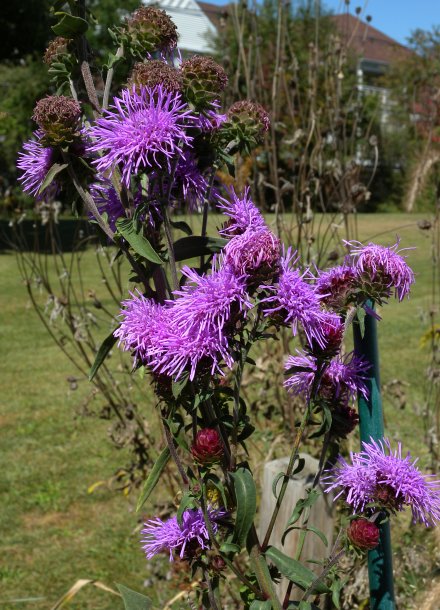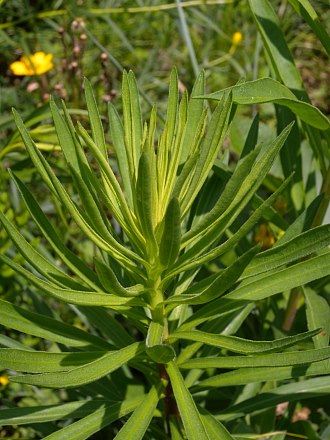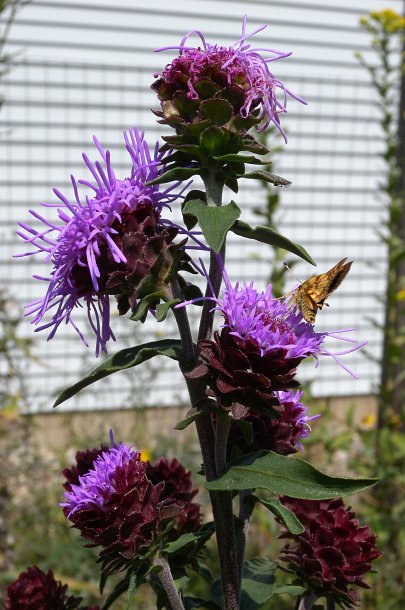Description: This perennial wildflower is 2½–5' tall, erect, and unbranched. The central stem is medium green, glabrous to short-pubescent, and terete. Numerous alternate leaves are arranged densely around the stem; they are widely spreading. The lower leaves are up to 12" long and 1½" across; they are broadly linear to elliptic oblong in shape. The middle to upper leaves become gradually smaller as they ascend the stem, becoming linear in shape and as little as 3" long. All of the leaves are medium green and their margins are smooth; they are usually hairless, except for their margins, which are often slightly ciliate. The lower leaves usually have petioles, while the middle to upper leaves are sessile. The inflorescence consists of a narrow raceme of flowerheads up to 2' long. The flowerheads begin to bloom from the top of inflorescence, then they gradually bloom below until the bottom is reached. Each inflorescence has 10-40 flowerheads. Each flowerhead is located at the apex of an ascending stalk (peduncle) about ½–3½" long; a stalk may branch to produce 2-3 flowerheads, but this is atypical. At the base of each stalk, there is a sessile leafy bract that resembles the upper leaves. Both the central stalk and lateral stalks of the raceme are short-pubescent.

Individual
flowerheads span 1-2" across, consisting of 25-80 pink disk florets and
no ray florets. The tubular disk florets have 5 spreading narrow lobes.
The bifurcated styles are light pink and strongly exerted from the disk
florets, providing the flowerheads with a shaggy appearance. At the
base of each flowerhead, there are scale-like floral bracts
(phyllaries) that are arranged together in about 5 overlapping series;
they are ascending to slightly spreading, but neither recurved nor
appressed. Individual floral bracts are oval or obovate in shape and
ciliate along their margins; they become dark reddish purple when their
flowerheads bloom, otherwise they are dull green. The blooming period
occurs from late summer to mid-fall and lasts about 1½ months. The disk
florets are replaced by bullet-shaped achenes, which have tufts of
barbed tawny hairs. The root system consists of a bulb-like corm with
fibrous roots. Vegetative offsets are produced from new corms.
Cultivation:
This wildflower can adapt to full or partial sun, moist or mesic
conditions, and different kinds of soil, including those that are
loamy, sandy, or gravelly. It can tolerate a little more shade than
other Liatris spp. (Blazingstars). In the garden,
individual plants can become top-heavy during the blooming period and
topple over, unless they are tied to stakes.

Range &
Habitat:
The native Savanna Blazingstar is found in west-central and NE
Illinois, where it
is rare; in other sections of the state, it is absent (see Distribution
Map). This species is state-listed as 'threatened.' Habitats
consist of oak savannas and prairies; sometimes these habitats are
sandy. In other states, this species is found in rocky glades and
savannas with pine trees. Savanna Blazingstar is found in high quality
habitats. It is endemic to the Midwest.
Faunal Associations:
The flowerheads attract butterflies and skippers primarily, especially
Monarch butterflies (Danaus plexippus). The caterpillars of some
oligophagous moths are known to feed on Liatris spp.
(Blazingstars). These species include Schinia sanguinea
(Bleeding Flower Moth), Schinia gloriosa (Glorious
Flower Moth), Papaipema beeriana (Blazingstar Borer
Moth), and Carmenta anthracipennis (Liatris Borer
Moth). There is also an oligophagous aphid, Aphis laciniariae,
that sucks juices from Blazingstars. The foliage is readily eaten by
deer, rabbits, groundhogs, cattle, and other mammalian herbivores.
Voles sometimes feed on the corms. This wildflower benefits from
occasional wildfires as this reduces the encroachment of woody
vegetation.

Photographic
Location:
The wildflower garden of the webmaster in Urbana, Illinois.
Comments:
This blazingstar can become quite tall and it produces hefty
flowerheads that are larger than those of other Liatris spp.
(Blazingstars). It is a very beautiful plant that should be cultivated
more often. Sometimes Savanna Blazingstar is considered a distinct
species, in which case it is referred to as Liatris
nieuwlandii. The typical variety of Liatris scariosa
(Northern Blazingstar), is found in areas to the east of Illinois, and
there is another variety that is found in New England. Savanna
Blazingstar can be distinguished from Liatris aspera
(Rough Blazingstar) by the ascending stalks of its flowerheads; the
flowerheads of Rough Blazingstar are sessile (or nearly so) and they
have fewer disk florets.